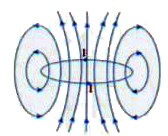Magnetic field →B is produced by a current. On the basis of this concept, Maxwell explained the existence of EM. Magnetic field is generally directed towards circumference of circular loop and ris the radius whose plane is perpendicular to direction of current carrying wire, which is centered symmetrically with respect to the wire

Conduction of current due to:
Current through conductor
Current through loop
Current on surface
Current between capacitor
Step by step video & image solution for Magnetic field vecB is produced by a current. On the basis of this concept, Maxwell explained the existence of EM. Magnetic field is generally directed towards circumference of circular loop and ris the radius whose plane is perpendicular to direction of current carrying wire, which is centered symmetrically with respect to the wire Conduction of current due to: by Physics experts to help you in doubts & scoring excellent marks in Class 12 exams.
Updated on:21/07/2023Topper's Solved these Questions
- SAMPLE PAPER 9 BOOK - EDUCART PUBLICATIONCHAPTER - SAMPLE PAPER 9 EXERCISE - SECTION - B
22 Videos
- SAMPLE PAPER 7BOOK - EDUCART PUBLICATIONCHAPTER - SAMPLE PAPER 7EXERCISE - SECTION-C
6 Videos
- SAMPLE PAPER SELF- ASSESSMENT -(10)BOOK - EDUCART PUBLICATIONCHAPTER - SAMPLE PAPER SELF- ASSESSMENT -(10)EXERCISE - SECTION-B
17 Videos
Similar Questions
Knowledge Check
Along the direction of current carrying wire, the value of magnetic field is ?
AzeroBinfinityCdepends on the length the wireDuncertainForce exist on a current carrying wire which is placed in external magnetic field, due to :–
Afree electrons in wireBfree positive ions in wireC(A) & (B) bothDnoneThe direction of the force on a current -carrying wire placed in a magnetic field depends on
Athe direction of the current but not on the direction of the fieldBthe direction of the field but not on the direction of the currentCthe direction of the current as well as the direction of the fieldDneither the direction of the current nor the direction of the field
Depict the direction of the magnetic field lines due to a circular current carrying loop.

View SolutionState the rule of determine the direction of magnetic field around a current - carrying wire .
View SolutionThe direction of the force on a current carrying wire placed in a magnetic field depends on
View SolutionThe direction of the force on a current carrying wire placed in a magnetic field depends on
View SolutionConsider the magnetic field produced by a finitely long current carrying wire .
View Solution
